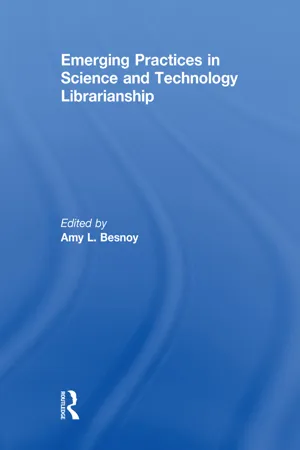AMY L. BESNOY
If there were one word to summarize this journal issue, it would be change. As technology changes around us, we must adapt to the changes while maintaining collections, providing access to resources, and ensuring that in this difficult economic time we make prudent decisions about our limited financial resources. Further, we are called to expand the vision of what librarians and libraries do to stay current and relevant. The library, after all, is a growing organism (Ranganathan, 1963) and with growth comes change and adaptability.
I had the good fortune—and perhaps foresight—to attend the Association of Research Libraries Fall Forum: Reinventing Science Librarianship in Washington, DC, in October 2008. There, I met a remarkably impressive group of people, and the topic for this journal issue began to develop. Over time, this issue has taken shape with an array of scholars from North America who are thoughtful and engaging. It has been an honor to work with them as these special issues has evolved and changed. The patterns of this issue are intriguing to me as a large number of the submissions are specific to pedagogy, and there is much variation and range within this area—how we as librarians integrate our lessons into curriculum and in the classroom by partnering with teaching faculty and embedding ourselves in curriculum design and delivery. Cecelia Brown and June Abbas address the complexities of institutional repositories in a remarkably accessible manner. Kay Cunningham clearly illuminates that just staying current is going to cost money amidst the rapidly changing information landscape. The scientific community and Web 2.0 social networking technologies are surveyed by Sue O’Dell and discussed as part of what she refers to as the ongoing discovery process. Maliaca Oxnam highlights a successful collaboration across typically disparate entities through a collaborative partnership of engineering and government document librarians to achieve digital access and preservation of federal government technical reports. Through a survey examining students’ attitudes toward science literacy and lifelong learning as addressed in the Association of College Research Libraries (ACRL)’s Science and Technology’s Information Literacy standards, Irina Holden concludes that to achieve responsible citizenship, science literacy must intersect with lifelong learning.
Collection and retention decisions are driven largely by data, especially in difficult financial times, and the data to make collection decisions must be accompanied by narrative to assist in its interpretation, Locke Morrisey imparts. In the subsequent issue, Norma Kobzina discusses a unique relationship with the teaching faculty of an interdisciplinary course in which librarians and library staff worked closely with faculty and graduate student instructors to collaboratively develop course-related instruction programs. By linking her university’s learning objectives with the ACRL Science and Technology’s Information Literacy standards, Jeanine Marie Scaramozzino sets forth a comprehensive and integrated program for bringing information literacy into the Science, Technology, Engineering and Mathematics (STEM) curriculum.
An exploration of evolving digital services is handled well by Carol Hunter, Sherry Lake, Carla Lee, and Andrew Sallans. Their case study addresses the intrinsic interdisciplinary nature of the library and the trend to merge IT with libraries and the unique cultures within each organization. Scott Warren and Kim Duckett bring students into the economic conversation of the high price of science materials and differentiate between locating and accessing content. Peggy Pritchard suggests a continuum of librarian involvement ranging from supplemental to embedded, which is dependent on the support of the departmental teaching faculty. Managing productivity is addressed by Catherine K. Craven, Victoria Goode, Claire Twose, Dongming Zhang, and Nancy Roderer in their interesting discussion of the database management system their institution implemented to quantitatively assess service.
Throughout Parts 1 and 2 of these special issues, the reader will encounter a variety of terms for librarian—informationists, information specialists, subject specialists—and for libraries—knowledge centers, Learning Commons, research centers. Regardless of the names, the work and resources are changing. Access across platforms and disciplines are becoming increasingly more complex and we are called to consider revising our teaching, collection and retention processes, access points, assessment tools, productivity expectations, and, in some ways, our identities as science and technology librarians.
